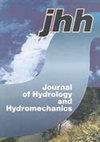Impact of reconfiguration on the flow downstream of a flexible foliated plant
IF 2.4
4区 环境科学与生态学
Q3 WATER RESOURCES
引用次数: 0
Abstract
Abstract This paper explores the impacts of reconfiguration and leaf morphology on the flow downstream of a flexible foliated plant. 3D acoustic Doppler velocimetry and particle image velocimetry were used to experimentally investigate the hydrodynamic interaction between a foliated plant and the flow, testing two plants with different leaves morphology under different bulk flow velocities. The model vegetation was representative of riparian vegetation species in terms of plants hydrodynamic behavior and leaf to stem area ratio. To explore the effects of the seasonal variability of vegetation on the flow structure, leafless conditions were tested. Reconfiguration resulted in a decrease of the frontal projected area of the plants up to the 80% relative to the undeformed value. Such changes in plant frontal area markedly affected the spatial distributions of mean velocity and turbulence intensities, altering the local exchanges of momentum. At increasing reconfiguration, the different plant morphology influenced the mean and turbulent wake width. The leafless stem exhibited a rigid behavior, with the flow in the wake being comparable to that downstream of a rigid cylinder. The study revealed that the flexibility-induced reconfiguration of plants can markedly affect the local distribution of flow properties in the wake, potentially affecting transport processes at the scale of the plant and its subparts.重新配置对柔性叶片工厂下游流量的影响
摘要本文探讨了重组和叶片形态对柔性叶片植物下游流动的影响。采用三维声学多普勒测速仪和粒子图像测速仪对叶片状植物与水流之间的流体动力学相互作用进行了实验研究,测试了两种不同叶片形态的植物在不同整体流速下的流动。就植物的水动力行为和叶茎面积比而言,模型植被是河岸植被物种的代表。为了探讨植被季节变化对流量结构的影响,对无叶条件进行了试验。重构导致植物的正面投影面积相对于未变形值减少了80%。植物锋面面积的这种变化显著影响了平均速度和湍流强度的空间分布,改变了局部动量交换。在增加重构时,不同的植物形态影响平均尾流宽度和湍流尾流宽度。无叶茎表现出刚性行为,尾流的流动与刚性圆柱体下游的流动相当。研究表明,柔性诱导的植物重新配置会显著影响尾流中流动特性的局部分布,可能会影响植物及其子部分规模的运输过程。
本文章由计算机程序翻译,如有差异,请以英文原文为准。
求助全文
约1分钟内获得全文
求助全文
来源期刊
CiteScore
4.20
自引率
5.30%
发文量
30
审稿时长
>12 weeks
期刊介绍:
JOURNAL OF HYDROLOGY AND HYDROMECHANICS is an international open access journal for the basic disciplines of water sciences. The scope of hydrology is limited to biohydrology, catchment hydrology and vadose zone hydrology, primarily of temperate zone. The hydromechanics covers theoretical, experimental and computational hydraulics and fluid mechanics in various fields, two- and multiphase flows, including non-Newtonian flow, and new frontiers in hydraulics. The journal is published quarterly in English. The types of contribution include: research and review articles, short communications and technical notes. The articles have been thoroughly peer reviewed by international specialists and promoted to researchers working in the same field.

 求助内容:
求助内容: 应助结果提醒方式:
应助结果提醒方式:


